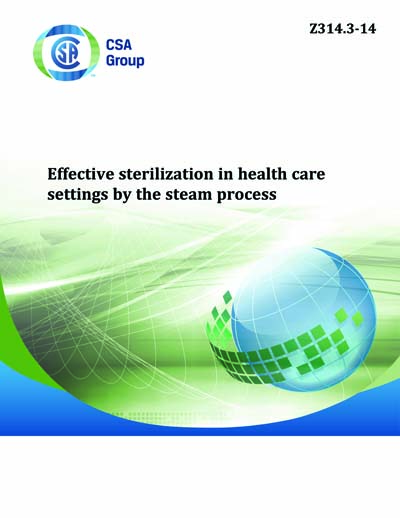Historical
CSA Z314.3-2014
Z314.3-14 - Effective sterilization in health care settings by the steam process
Preface
This is the sixth edition of CSA Z314.3, Effective sterilization in health care settings by the steam process. It supersedes the previous editions, published in 2009, 2001, 1991, 1985, and 1979. It is designed to be used with CSA Z314.0 Medical device reprocessing - General requirements and others in a series of CSA Group Standards dealing with the safe and effective sterilization of medical supplies and equipment.Introduction
Medical devices are used in nearly every medical procedure. Patients and health care professionals expect these medical devices to be functionally and microbiologically safe. The safety of medical devices begins with the manufacturer and is supported and maintained by a system of national standards and government regulations that includes medical device licensing, construction and performance standards, and problem reporting systems. Within this structure, areas or departments that reprocess medical devices within or for a health care setting play an essential role and face unique challenges. Unlike a medical device manufacturer, medical device reprocessing personnel work with a wide array of medical devices manufactured by different companies, received in varying states of cleanliness and repair. It is the responsibility of the Medical Device Reprocessing Department (MDRD) to decontaminate, inspect, perform necessary maintenance, and disinfect or sterilize each medical device using the device manufacturer validated methodologies. The goal is to provide medical devices that perform as intended by the manufacturer and are safe for reuse. This Standard is one of a series of standards to be used in conjunction with CSA Z314.0, Medical device reprocessing - General requirements, which provides a framework to establish, document, and maintain requirements for the reprocessing of medical devices as part of a quality management system. CSA Z314.3 is intended to provide requirements for the safe and reliable steam sterilization of reusable medical devices, water and steam quality, and extended steam sterilization cycles.Scope
1.1 This Standard specifies essential elements for using steam to sterilize medical devices in health care settings, with the object of achieving an adequate level of sterility assurance and minimizing the risk of injury to health care setting personnel and patients. Notes: 1) The term health care setting includes, but is not limited to, hospitals, nursing homes, extended-care facilities, clinics, medical and dental offices, and health units in industry. See CSA Z314.0 for a more comprehensive definition. 2) Comprehensive guidance for small, community health care settings can be found in CSA SPE-1112. 1.2 This Standard includes requirements for a) sterilization equipment including tabletop sterilizers; b) preparation and packaging of medical devices requiring sterilization; c) sterilizer loading and operation; d) sterility assurance, including process challenge device (PCD) construction and use; and e) immediate use steam sterilization (IUSS). Note: IUSS (also known as flash or emergency sterilization) is usually performed outside of the MDRD. 1.3 This Standard does not apply to a) manufacturers' requirements for construction and performance of steam sterilizers; Note: See CAN/CSA-Z314.7. b) washer/sterilizers; c) decontamination of reusable medical devices prior to sterilization; Note: See CSA Z314.8. d) chemical sterilization; Note: See CSA Z314.23. e) single-use/disposable medical devices; or Note: See the Canadian Healthcare Association, the ECRI Institute, and the Canadian Agency for Drugs and Technologies in Health. f) medical devices that have been used with patients who are known or suspected to have Creutzfeldt-Jakob Disease (CJD) or prion-related diseases. Note: See Public Health Agency of CanadaClassic Creutzfeldt-Jakob Disease in Canada - Quick Reference Guide and Classic Creutzfeldt-Jakob Disease in Canada. 1.4 In this Standard, shall is used to express a requirement, i.e., a provision that the user is obliged to satisfy in order to comply with the standard; should is used to express a recommendation or that which is advised but not required; and may is used to express an option or that which is permissible within the limits of the standard. Notes accompanying clauses do not include requirements or alternative requirements; the purpose of a note accompanying a clause is to separate from the text explanatory or informative material. Notes to tables and figures are considered part of the table or figure and may be written as requirements. Annexes are designated normative (mandatory) or informative (non-mandatory) to define their application.Content Provider
CSA America, Inc. [csa]






